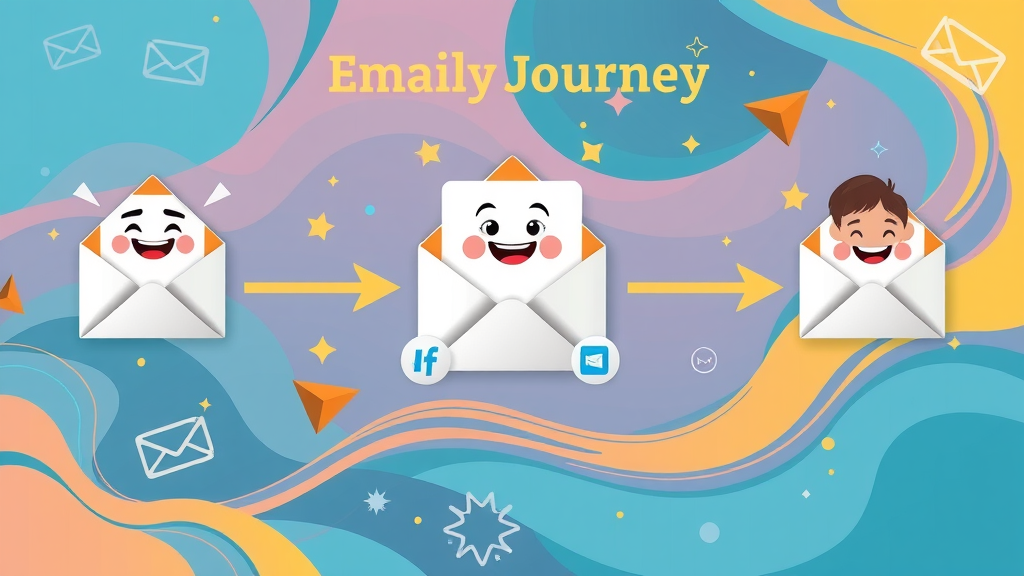Did you know that over 70% of leads in property services never become paying customers simply because businesses don’t follow up enough after sending a quote? Effective email sequences to convert can be your golden ticket for turning quotes into real jobs, unlocking revenue that would otherwise walk away. This guide will show property services business owners and managers how to harness AI-powered automation and build trust-fuelled email journeys that actually convert, every time.
A Surprising Truth: Why Most Email Sequences to Convert Fail Property Services Businesses
Recent data reveals a startling challenge for the property services sector: over 70% of leads never move past the initial quote, mainly due to poor follow-up. This isn’t just a missed opportunity— it’s lost revenue that could make a measurable difference to your bottom line. Effective email sequences to convert are often underestimated, with most businesses sending a single generic follow-up (or none at all!). Automated, strategic follow-ups powered by AI can flip this script, delivering timely, personal, and relevant messages that pull prospects back in and convert more quotes into paying jobs.
"Only 30% of small business owners follow up more than once after sending a quote—leaving revenue on the table." – Industry Study (2023)

What You’ll Learn: How to Master Email Sequences to Convert Quotes into Jobs
- Definition and importance of email sequences to convert
- The anatomy of a high-performing sales email sequence
- Crafting automated email sequences using AI
- Lead nurturing and trust-building tactics
- Best practices for marketing automation in property services
- How to personalise subject lines and messaging
- Tracking KPIs and iterating for success

Understanding Email Sequences to Convert: Meaning, Value, and Impact
What are Email Sequences to Convert and Why Do They Matter?
An email sequence to convert is a planned series of emails—each designed to nurture a lead from quote to closed job. Unlike one-off messages, a well-designed sequence builds momentum, gently reminding busy prospects of your offer, addressing their needs, and keeping you top-of-mind. For property services businesses, where trust is critical, these sequences help you demonstrate reliability, professionalism, and problem-solving skills. An automated email sequence removes the guesswork: the right message goes out at exactly the right time, so no prospect slips through the cracks. In a sector where winning a single new client can mean thousands in revenue, the impact of strong follow-up cannot be overstated.
How Email Sequences to Convert Fuel Lead Nurturing and Build Trust
Successful lead nurturing is the secret sauce for moving leads down the sales funnel. Every email sequence to convert should act like a gentle guide, showing customers the value of your service, addressing their pain points, and proving that you care about their needs. Each step in the sequence builds trust—sharing testimonials, offering quick tips, and answering common questions—so that when they’re ready to book, you’re the obvious choice. AI-driven nurturing email strategies offer data-driven insights to further optimise your timing and messaging. It’s all about sending the right message at the right time—automatically.

The Components of a Successful Sales Email Sequence to Convert
Crafting the Perfect Subject Line for Email Sequences to Convert
Your subject line is the first—and sometimes only—thing your prospect sees. A good one directly impacts your open rate. For property services, use clear, action-focused lines like “Your Quote for [Service]—Let’s Get Started” or pose a relevant question (“Still Need That Leaky Roof Fixed?”). Personalisation is key: include the prospect’s name or specific property issue to spike curiosity. AI tools can even suggest subject lines that match your customer’s tone and preferences, boosting relevance. Pay attention to subject line best practices: keep it short, on-brand, and never misleading. Even a 10% increase in open rates can mean twice as many jobs booked!
From First Contact to Final Nudge: Email Sequence Stages
- Welcome email after the quote
- Follow-up and engagement email
- Overcoming objections / pain points with targeted messages
- Second-chance/re-engagement email sequence
- Final call to action email
| Stage | Timing | Sample Subject Line | Message Focus | Call to Action |
|---|---|---|---|---|
| Welcome Email | Immediately after quote | Your Quote for [Service]—What’s Next? | Confirm quote received; friendly intro; what to expect next. | Reply with any questions or schedule a call |
| Engagement Email | 2 days after quote | Still Thinking About [Service] at [Property Address]? | Highlight unique value prop and benefits; share social proof or testimonials. | Book your service or request a callback |
| Overcoming Objections | 4 days after quote | Got Questions About Your Project? | Address common pain points; provide answers to FAQs. | Click here for answers or speak with an expert |
| Second-Chance / Re-engagement | 7 days after quote | Still On The Fence? Let’s Make It Easy | Offer incentives (limited-time offer, discount, free trial) | Claim your offer or request another quote |
| Final Call to Action | 10 days after quote | Last Chance: Secure Your Spot for [Month] | Urgency + friendly sign-off + recap of benefits | Confirm your booking now |

How to Automate Email Sequences to Convert Quotes with AI
Marketing Automation Tools for Email Sequences to Convert
Today’s marketing automation platforms harness AI to streamline and personalise every step of your email sequence. Tools like Mailchimp, ActiveCampaign, and HubSpot are user-friendly and made for small businesses. They let you create if-this-then-that workflows: you can trigger a welcome email after a quote is sent, schedule follow-ups, and automatically segment lists based on behaviour or job type. AI-powered features can recommend the next step, optimise send times, and even generate copy tailored to each lead’s needs. These platforms put smart systems to work, boosting efficiency and helping local property services businesses close more quotes—without hiring extra staff.
Best Practices for Automated Email Sequences to Convert (with Examples)
- Segmenting your audience: Divide leads by service type, location, or urgency to make sure every email feels personal and relevant.
- Personalising email sequences: Use the client’s name, property address, or details from their quote request in subject lines and the message body.
- Using behavioural triggers: Automatically send follow-ups based on replies, clicks, or if a quote is viewed but not actioned.
- Automated follow-ups and scheduling: Keep your sequence running (even on weekends) so no lead waits too long for a response.

Lead Nurturing: Turning Quotes Into Loyal Property Services Clients
Lead Nurturing Tactics in Email Sequences to Convert
Lead nurturing isn’t just follow-up; it’s about building trust at every stage. Share helpful resources, showcase testimonials, and be proactive about addressing their pain points. Offer value from the first touch—maybe a quick tip on caring for their property or a checklist for making the right decision. Consider adding a free trial or a “client story” in your nurturing sequence to make your service more inviting. Remember, every email—even the automated ones—should feel like it’s written just for them. Consistent, value-driven engagement is what separates one-time customers from loyal, returning clients.
Addressing Pain Points with Targeted Nurturing Emails
Your prospects hesitate for a reason. Maybe they’re unsure about price, timing, or trust. Directly tackle these pain points in your nurturing emails. For example, if people often worry about hidden fees, mention your transparent pricing. If they fear disruption, highlight your quick turnaround and tidy job site practices. Sharing a quote from a happy customer or offering a free trial can tip the scales in your favour. The goal: make sure every email moves them one step closer to becoming a paying customer, using relevant stories, FAQs, and a clear call to action—every time.

Crafting Effective Sales Emails That Convert (With Templates)
Template: Quote Follow-Up Email Sequence to Convert
-
Template 1: Immediate follow-up
Subject: “Your Quote for [Service]—Next Steps”
Body: Thank the client. Summarise quote highlights and invite questions. -
Template 2: Overcoming objections
Subject: “Got Concerns About Your Project?”
Body: Address pain points (price, timing, trust). Share a testimonial. Offer more information. -
Template 3: Second-chance/re-engagement
Subject: “Still Deciding? Here’s a Special Offer”
Body: Offer incentive (free trial, discount) and restate unique value. -
Template 4: Final call to action
Subject: “Last Reminder: Book Your [Service] Today”
Body: Create urgency. Summarise key benefits. Clear call to action—book now!
Using Engagement Emails for Better Conversion Rates
Engagement emails are powerful tools for booking rates, especially when timed right. Send a quick check-in (“How can we help with your decision?”), share seasonal tips, or link to a helpful blog. Regular purposeful touchpoints remind prospects you’re attentive, available, and equipped to help them. This consistent presence builds trust and makes your service their top-of-mind pick when they’re ready.
"An engagement email at the right time can increase your booking rates by up to 50%." – Email Marketing Specialist

Key Best Practices for Email Sequences to Convert in Property Services
Industry Best Practice: Sales Email Sequence Strategies
- Keep emails concise and on-brand so they’re quick to read and instantly recognisable as your business.
- Leverage social proof and testimonials in every sequence to boost confidence and build trust.
- Always include a clear call to action—tell readers exactly what the next step is, whether it’s replying, booking, or asking a question.
Common Mistakes to Avoid in Email Marketing for Quotes
- Ignoring segmentation: Don’t blast the same message to everyone—personalisation is key.
- Overusing generic templates: Make sure your sequences sound human and tailored to the client’s needs.
- Neglecting analytics and improvement cycles: Review open rates, clicks, and bookings often for your email campaigns. Always be ready to test and tweak.

People Also Ask: Email Sequences to Convert
What is the best email sequence?
The best email sequence to convert starts with a warm welcome email after the quote, continues with personalised follow-ups and objection-handling, and closes with a clear final call to action. Make sure every message is relevant, caring, and consistent to maximise results.
How to automate email sequences?
Use email marketing automation tools that let you design workflows: set triggers for actions (like sending a quote), write content for every step, and let the software send your messages automatically. AI enhancements help with personalisation and timing, so you can focus on growing your business.
What are email sequences?
Email sequences are automated series of scheduled emails sent to leads or customers—moving them from first contact, through nurturing, all the way to booking or purchase. They guide each person through the sales journey step by step.
How to create emails that convert?
Start with a catchy subject line, personalise your message, speak to the prospect’s pain points or goals, and always end with a strong call to action. Review your email campaign analytics regularly to improve your results over time.
Tracking the Success of Your Email Sequences to Convert
Key Performance Indicators for Email Sequences
- Open rates
- Click-through rates
- Response rates
- Conversion/booking rates
| Metric | Benchmark | What Success Looks Like |
|---|---|---|
| Open Rate | 30–45% | Above 40% suggests excellent subject line & targeting |
| Click-Through Rate (CTR) | 6–12% | Above 10% means high message relevance |
| Response Rate | 8–18% | Shows strong engagement/interest |
| Conversion/Booking Rate | 5–15% | Anything 10%+ is industry-leading |
Iterating and Improving Email Campaign Performance
Always A/B test subject lines, split test message content, and review your campaign performance monthly. Small tweaks—like a new call to action or updated testimonial—can make a big difference. Regular optimisation is a best practice that keeps your email campaigns fresh and highly effective for your audience.

FAQs: Email Sequences to Convert Quotes for Property Service Businesses
-
How often should I follow up after sending a quote?
Aim for 3–5 follow-ups over 10 days, spaced to avoid being intrusive but persistent enough to stay top-of-mind. -
Are AI-powered email sequences expensive?
No—most automation platforms offer plans tailored to small businesses. The value gained in additional bookings usually far outweighs the cost. -
How do I ensure email templates don’t sound robotic?
Personalise every message. Use first names, reference specific services, and add a friendly, conversational tone to feel genuine. -
What is the best time of day to send a follow-up email?
Late morning and early afternoon (10:00am–2:00pm) tend to get the best open rates, but testing different times on your audience is ideal.
Key Takeaways: Email Sequences to Convert for Property Services
- Automated email sequences to convert are essential for maximising revenue from quotes.
- AI and marketing automation streamline lead nurturing and build trust with prospects.
- Personalisation and segmentation are critical best practices for higher conversion rates.
- Consistent improvement and tracking drive even better outcomes for your email campaigns.

Conclusion: Streamline Your Path from Quote to Paid Job with Smart Email Sequences to Convert
Email sequences to convert can be your most powerful sales engine: boosting conversions, impressing prospects, and unlocking growth with less manual effort. With AI-powered automation, it’s never been easier to make every lead count.
Next Steps: Put AI-Powered Email Sequences to Convert Into Action
Discover more about putting AI to work in your business – contact us at AI@dylbo.com
Watch this practical explainer video for property services business owners—learn how to set up, automate, and optimise your own email sequence for consistent results.
See a local property services business share how smart email sequences transformed their quote-to-job conversion rate and client loyalty—proof that these strategies really work.
To enhance your understanding of crafting effective email sequences that convert, consider exploring the following resources:
- “From Cold to Sold: Building Effective Email Sequences That Convert” (buffsend.com)
This article delves into the psychology behind successful email sequences, emphasizing the importance of multiple touchpoints to build trust and familiarity with prospects.
- “9 Types of Email Sequences to Ramp up Conversions (+ Tips)” (unlayer.com)
This resource outlines various email sequence types, such as welcome, lead nurturing, and re-engagement sequences, providing best practices to optimize each for higher conversion rates.
If you’re serious about automating your follow-up processes and turning quotes into paying jobs, these resources will offer valuable insights and actionable strategies to implement in your email marketing efforts.
 Add Row
Add Row  Add
Add 










Write A Comment